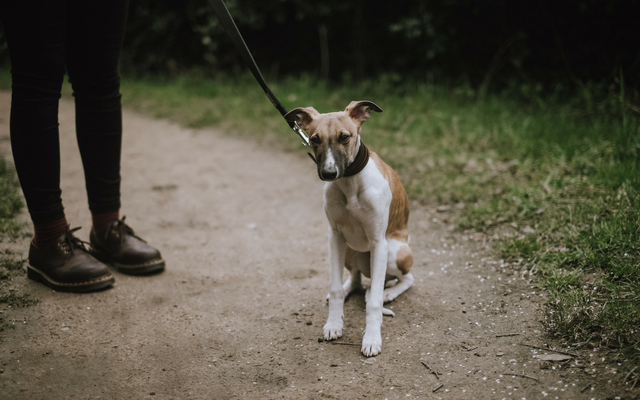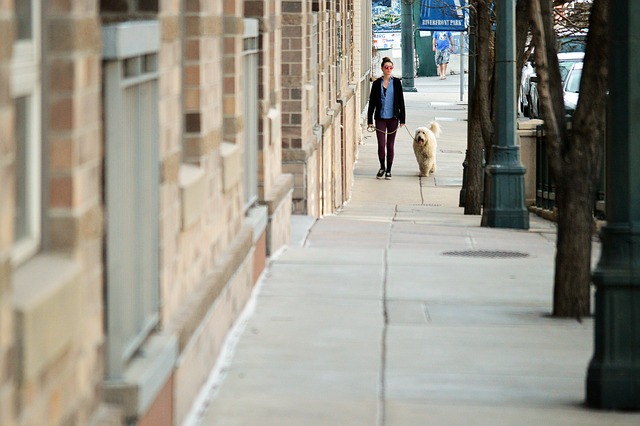Heading out on walks is one of the first things families look forward to after bringing home their newest four-legged friend. It’s supposed to be a time-honored tradition between man and man’s best friend where both ends of the leash have a grand time, but it unfortunately doesn’t always start out that way. Instead of being the dog’s favorite part of the day, the prospect of leaving the house for a trip around the block can be terrifying.
They run when they see the leash, resist all efforts to put their harness on, and dig their paws into the carpet when faced with the intimidating expanse that is an open front door. Once they’re outside, it only gets worse. Their tail stays tucked between their legs, and their steps are slow and hesitant. Some dogs also lash out with fear-based aggression. You want your pup to enjoy all the best things in life, and that includes the joy of going on a relaxing walk. Here are some tips to get them there.

Don’t Walk Too Soon
You assume the day you adopt your dog will be the best day of their life, but in reality, it’s one of the most stressful. They’re taken from at least a semi-familiar environment at the shelter, introduced to brand new people, dropped into a strange new house with new smells, sounds, and experiences, and while everyone is nice to them, excitement is overwhelming. Rescue dogs deal with a lot in the first few days after being adopted. Going on walks is one more thing for them to worry about. They’re already forced to adapt to a new indoor environment, and for some, being introduced to new outdoor surroundings at the same time is too much to handle.
If your dog is showing signs of being nervous or afraid, give them a few days to adjust to their change in circumstance before going on their first walk. You can also use that time to actively work on improving your dog’s overall confidence. This article from iHeartdogs goes over ways to do that.
Never Use Force
It can be tempting to clip on the leash and literally drag your frightened rescue dog out the door, but that form of “tough love” will only make the situation worse. Canine behaviorists call the technique that forces a dog to face their biggest fears “flooding,” and most agree it’s the wrong way to go. Applied Animal Behaviorist Karen Overall told Pet Helpful,
“The use of flooding is almost always inappropriate…exposing a fearful or fearfully aggressive dog to a stimulus of which he is afraid of but cannot escape will make the fear worse.”
Instead of forcing them to face their fears all at once, behaviorists suggest a training method called desensitization conditioning. This technique is all about baby steps. Start by getting your dog used to wearing their harness and leash. Put it on for a few minutes every day without going outside. Make sure to give them plenty of treats and praise while they’re leashed up, and stop the positive reinforcement when you take it off. Once they’re comfortable with wearing the harness, move them toward the door. Let them look out the door without actually crossing the threshold. Use the same treats and praise, but don’t move too fast. From there, you can try taking a step or two outside. The goal is to go a little farther every few days, but only move forward when the dog is showing signs of being completely comfortable.

Choose the Right Times
Neighborhoods work like clockwork, and there are certain times of the day when you can’t check your mail without seeing a neighbor or two out and about. They’re out walking their dogs, jogging, mowing their lawns, and doing all sorts of noisy and unpredictable things. Having a lot going on will make a nervous dog feel even more uncomfortable on a walk. The last thing you want is for a surprise experience to ruin all the good work you’ve done to get your dog out the door.
Both you and your dog will benefit from finding the right time for your walking adventures. In most neighborhoods, the hours when people are getting home from work are the busiest. Fellow dog owners get home from eight-hour shifts, and the first thing they do after changing out of their work clothes is take the dog for a walk. It’s a great time for social, confident dogs to meet their doggy buddies out on the sidewalk, but it’s not so great for your dog that would rather avoid all extra stimulation. Early morning before people leave for work is also prime time for joggers and dog walkers. You’ll have better luck having the sidewalk to yourself if you plan your walks during non-peak neighborhood hours. It might require you to wake up early or adjust your daily schedule, but your dog will feel more confident without all the noise and stimulation of other people and their pets.
Avoid Threatening Things
Walking at the right time will help you avoid situations that could potentially make your dog’s anxiety worse, but you still need to be on the look out for possible problems. Always look ahead, behind, and to the sides to spot approaching people, animals, and particularly noisy vehicles before they’re right on top of you.
Until your dog is more comfortable on walks, it’s best to avoid all things that will scare her. You’ll eventually want to work on socialization and introducing her to new things, but that’s a lesson for another, more confident day. If a person walks up to you, kindly ask them to keep a distance from your dog. If you see a neighbor heading your direction with their rambunctious pup, casually cross the street or head in a different direction.

Carry Treats
Dogs live through associations, and those feelings can be either positive or negative. When your dog seems to be walking on eggshells instead of a sidewalk, they’re harboring some kind of negative association with what they’re doing. You want to change their perspective by giving them something positive to connect the experience with. Treats work well for this.
Before you leave the house, fill your pockets with high-value treats, or better yet, buy a fanny pack or another kind of easy-access bag specifically for transporting dog treats. When you’re out trying to walk, use the treats to reward your dog for confident behavior. If they see a squirrel and don’t freak out, give them a treat. If they pass a person without tucking their tail between their legs, give them a treat.
Establish a Trustworthy Pack
Like their wild ancestors, it’s a dog’s instinct to feel most secure surrounded by their pack. In your dog’s world, a pack can take on any number of different sizes and shapes. Ideally, their pack is made up of the people they trust most in their family. It could include other dogs, or it could be them and their favorite group of humans. The only requirement is all members have to help them feel more comfortable and safe. There’s strength in numbers, and walking with a pack can give dogs the confidence they need to enjoy themselves. Your Dog Magazine says,
“The presence of another person can have a calming effect on both you and your dog. You will often feel more confident and able to cope if someone else is with you (provided it’s a calm and sensible person,), while walking with the dog in-between the two of you can be reassuring to him in situations which make him anxious.”
As your dog’s confidence on walks grows, you can experiment with walking with fewer pack members. The pack is like training wheels, and the goal is to help the dog eventually be brave enough to walk all on their own–well, besides the person holding the leash.

Use Calming Essential Oils
Essential oils are a popular way for people to naturally adjust their moods, and they can also be used with dogs. The trick is to find high-quality products that are safe for pets. Do your research before buying from a company to make sure it won’t harm your dog. There are several essential oils that address anxiety. Lavender, neroli, petigrain are examples. See these 7 Tips For Choosing The Best Pet-Safe Essential Oils.

If you want to use essential oils to specifically benefit your dog while out on a walk, you’ll have the best results through direct inhalation. The Calming Aromatherapy Bandanas from iHeartdogs are a great portable way to take the benefits of essential oils everywhere your dog goes. All you have to do is place a drop of the oil of your choice on the felt heart, insert the heart into the slot in the bandanna, and secure the bandanna around the dog’s neck. It serves as your dog’s personal anti-anxiety-infused air supply.

Featured Photo by Mitchell Orr on Unsplash
h/t: Pet Helpful, Your Dog Magazine
